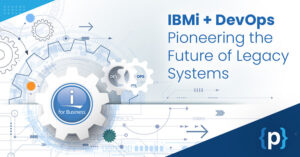DevOps observability is an important concept for any organization that wants to improve their operations, increase efficiency, and reduce risk. With DevOps observability, businesses can understand how their systems are performing in real-time, identify potential problems before they become major issues, and optimize processes to reduce costs and improve customer experience.
Companies use DevOps observability solutions to monitor various systems such as application performance monitoring (APM), infrastructure health monitoring (IHM), cloud services management (CSM), incident response tracking (IRT), log management (LM) and security analytics.
These tools enable organizations to proactively identify issues before they occur or escalate into bigger problems. Additionally, by using these solutions to gain insight into the system’s performance, businesses can optimize workflows and processes to reduce costs, increase efficiency and improve customer satisfaction.
DevOps observability solutions also enable organizations to gain visibility into the performance of their systems from both a technical and non-technical perspective. DevOps observability tools provide insight into system behaviors, application performance metrics, as well as user activity patterns. By understanding these various aspects of the operation, businesses can make informed decisions about how to best improve operations or adapt to changing market conditions.
In addition to improving operational efficiency and reducing risks associated with running critical systems, DevOps observability tools help create an overall culture of collaboration between different teams within an organization.
These tools allow development teams, IT departments and other stakeholders across the business to quickly and accurately identify issues and come up with solutions. By encouraging collaboration, businesses can more quickly resolve problems and improve the overall quality of their products, services and customer experience.
Ultimately, DevOps observability gives organizations the tools they need to monitor the performance of critical systems in real-time, reduce operational risks and optimize processes for improved efficiency.
By understanding how their systems are performing, companies can better adapt to changing market conditions and provide a better customer experience. With this newfound insight into operations, businesses can make informed decisions that help them succeed in today’s increasingly competitive markets.
DevOps observability is essential for any organization that wants to keep ahead of the competition and remain successful in today’s digital landscape. With the right observability solution in place, businesses can become more agile, reduce operational risks and optimize processes to stay competitive. Investing in DevOps observability can help companies realize their goals and ensure that they continue to thrive well into the future.
The Benefits of DevOps Observability for a Business
DevOps observability helps businesses to save time, money, and resources. By introducing automation into the software development lifecycle, organizations can easily identify problems with their applications faster and earlier than manual methods allow. DevOps observability also allows developers to better understand the impact of changes they make on the performance of their applications. This in turn can help them improve code releases and accelerate innovation.
In addition, DevOps observability helps teams achieve greater collaboration by providing real-time visibility across all parts of the system. By using tools such as dashboards, graphs, and logs, teams can quickly spot patterns, trends and issues that need attention so that action can be taken to correct them before an incident occurs. This type of collaboration is essential for the success of any business.
Finally, DevOps observability enables organizations to create better products and services faster by providing insights into user usage patterns and customer feedback. The ability to track how customers use an application can help developers pinpoint areas that need improvement and build features that meet user needs. This improved understanding of customer behavior allows businesses to provide a better experience that leads to increased customer satisfaction and loyalty.
Overall, DevOps observability provides a number of benefits for businesses, including time savings, cost reductions, improved collaboration, and product optimization. By using automated tools to monitor their applications’ performance in real-time, teams can quickly identify problems and make more informed decisions about the development process.
In addition, they can use customer feedback and usage analytics to better understand how their products and services are being used and make improvements to meet user needs. With DevOps observability, businesses can ensure that their applications are running smoothly, efficiently, and securely in order to maximize success.
How to Implement DevOps Monitoring and Observability?
DevOps monitoring and observability should be implemented holistically. Here are some best practices that organizations can follow to ensure successful implementation:
1. Define clear objectives for DevOps monitoring.
Organizations must establish clear goals for how they want to track their deployment cycles, performance metrics, and application health. It’s important for teams to define the specific metrics that need to be monitored in order to make informed decisions about their DevOps processes.
2. Foster collaboration across teams.
Monitoring and observability require the participation of multiple teams from development, operations, support, security, infrastructure, and more. By fostering collaboration between these departments and sharing information on a regular basis, organizations can ensure everyone has access to the same data points needed for DevOps monitoring.
3. Leverage existing tools and frameworks.
Many modern organizations already have the necessary tools and frameworks in place for successful DevOps monitoring, such as cloud native technologies like Kubernetes, Prometheus, and Grafana. Organizations should take advantage of these platforms to monitor their deployments and applications more efficiently and effectively.
4. Automate processes whenever possible.
Automation is key when it comes to DevOps monitoring, as manual checks are inefficient and prone to errors. Automated processes help teams quickly identify issues, optimize performance metrics, and ensure code quality standards are being met across all environments.
5. Evaluate external factors that could impact performance.
Organizations must evaluate any external factors that could potentially affect their system performance, such as network speeds, APIs or other third-party services. This can help teams identify any potential bottlenecks and take proactive steps to address them before they become an issue.
6. Invest in the right monitoring solutions.
Organizations must invest in the right monitoring tools and platforms to ensure they have visibility into their DevOps processes and applications. These solutions should provide comprehensive data on performance metrics, application health, deployment cycles, infrastructure resources, security posture, and more.
7. Measure success with KPIs and SLAs.
To measure the success of DevOps monitoring initiatives, organizations should set key performance indicators (KPIs) that track the overall system performance and service level agreements (SLAs) that monitor the uptime of their applications. This can help teams find areas of improvement and adjust their processes accordingly.
By following these best practices, organizations can ensure successful implementation of DevOps monitoring and observability initiatives. With the right tools in place, teams can gain visibility into their systems and quickly identify potential issues to optimize performance and improve customer experience.




